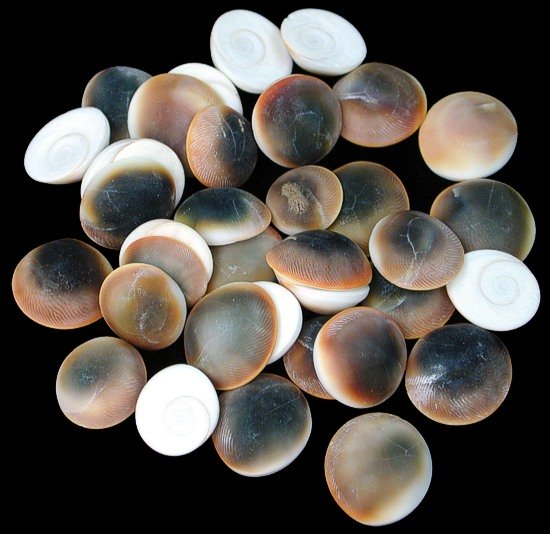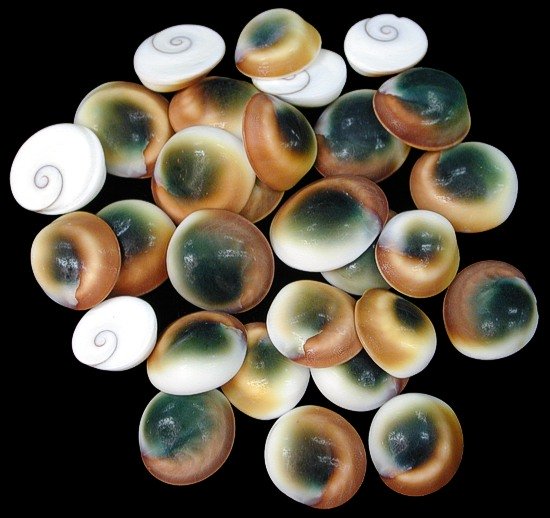OPERCULUM/CAT EYE
The operculum (from Latin operculum 'cover, covering'; pl opercula or operculums) is a corneous or calcareous anatomical structure like a trapdoor that exists in many (but not all) groups of sea snails and freshwater snails, and also in a few groups of land snails; the structure is also found in some marine and freshwater gastropods.
Calcareous is a term applied to anatomical structures which are made primarily of calcium carbonate, in animals such as gastropods, i.e., snails, specifically in relation to such structures as the operculum.
The operculum is attached to the upper surface of the foot and in its most complete state, it serves as a sort of "trapdoor" to close the aperture of the shell when the soft parts of the animal are retracted. The shape of the operculum varies greatly from one family of gastropods to another. It is fairly often circular, or more or less oval in shape. In species where the operculum fits snugly, its outline corresponds exactly to the shape of the aperture of the shell and it serves to seal the entrance of the shell.
The aperture is an opening in certain kinds of mollusk shells: it is the main opening of the shell, where the head-foot part of the body of the animal emerges for locomotion, feeding, etc.
Many families have opercula that are reduced in size, and which are not capable of closing the shell aperture. Opercula have sometimes been modified: in the Strombidae(true conch shells) the operculum is claw-shaped and is used to push into the substrate in a leaping form of locomotion.
Perhaps the most essential function of the operculum in gastropods is to allow snails to resist drying out. This is very important in intertidal zones marine during low tide, it also enables operculate freshwater and land snails to survive periods of drought and dry weather.
When the operculum completely seals the shell, it can also serve as a protection against predators when the snail body is retracted.
In life, the operculum is attached at the ending of the columellar muscle with an opercular disc dorsally to the upper surface of the posterior part of the foot. However, in Buccinum (true Welk shells) a layer of long cylindrical epithelial cells, with mostly distinct nuclei, and long divided processes enter between the muscular fibers. The operculum, a cuticular development of these cells, is composed, as may be seen in the corneous opercula of Murex, Purpura, Triton, of very thin superimposed layers. The cylindrical cells are attached with their head to the lowermost layer
The columella (meaning "little column") is a central anatomical feature of a coiled snail shell, a gastropod shell. The columella is often only clearly visible as a structure when the shell is broken, sliced in half vertically, or viewed as an X-ray image.
The columella runs from the apex of the shell to the midpoint of the undersurface of the shell, or the tip of the siphonal canal in those shells which have a siphonal canal. If a snail shell is visualized as a cone of shelly material which is wrapped around a central axis, then the columella more or less coincides spatially with the central axis of the shell. In the case of shells that have an umbilicus, the columella is a hollow structure.
The operculum grows in size as the shell grows, such that the operculum remains in proportion to the apertural size. In many species, when the animal is active and crawling, part of the underside of the shell rests on the outer surface of the operculum.
In many species of marine shelled snails which live sub tidally, the operculum is greatly reduced in size, and no longer serves to seal the shell entrance. In a large number of families it has been eliminated completely.
In species of conchs, the operculum is elongated and sickle-shaped, and is used to dig into the sand to enable the conch to perform a leaping type of locomotion.
The structure of the operculum can be described as:
concentric: the nucleus is central or subcentral as in Lithoglyphus and Ampullaria, and in other the nucleus is near the parietal margin of the shell.
imbricated, or lamellar: when it grows only on one side, and the nucleus is marginal, as in Purpura, Xenophora, and Paludomus.
claw-shaped, or unguiculate: with the nucleus apical or in front, as in Turbinella and Fusus; it is claw-shaped and serrated in Strombus (conch)
spiral: when it grows only on one edge, and revolves as it grows; it is always sinistral (of or on the left side) in dextral (of or on the right side) shells.
paucispiral (Having few spirals or whorls): with few spirals as in Littorina.
subspiral or scarcely spiral, in Thiara
multispiral or polygyrous: having many closely spaced spirals as in Trochus where they sometimes amount to twenty; the number of turns which the operculum makes is not determined by the number of whorls in the shell, but by the curvature of the aperture, and the necessity that the operculum should revolve fast enough to fit it constantly.
articulated, when it has a projection, as in Nerita
radiated is a modification of the articulated operculum in which the spiral is not so evident as in Navicella
There are two basic types of opercula in terms of their material composition:
The most common kind of operculum is composed of a thin to rather thick corneous protein material, which is yellow to brownish in color and is usually somewhat translucent. This matter is supple when in its natural state but may become brittle when it is dried out. The operculum varies in shape, depending on the family of snails and the shape of the aperture of their shells.
The other kind of operculum is restricted to a few families of gastropods including the Turbinidae. This operculum structure has a corneous base with a heavy calcareous overlay. The calcareous surface in some genera has color or ornamentation of various kinds including, for example, pustules and incised grooves. The different shapes of opercula can include ungulate (hooflike), claw-like, or ovate. The type and shape of the operculum is used to help identify and classify related groups (genera) of land operculates, and likewise some marine operculates.
The operculum of certain species of Turbinidae is sometimes used as a very inexpensive organic "gemstone" in rings, bracelets, amulets etc. These opercula are commonly known as "cats eye".
The turban snail Turbo petholatus is the species whose operculum is most widely used, although the operculum of other species of Turbo are sometimes used. The operculum is almost always given a solid setting, because it has one unattractive flat and corneous (callus) side where it was attached to the animal, and one roughly hemispherical glossy side, which, in the case of T. petholatus has a dark green area.
(REF: Tryon G. W. (1882). Structural and systematic conchology. Philadelphia, The author) (REF: Checa, Antonio G.; Jiménez-Jiménez, Antonio P. (1998). "Constructional Morphology, Origin, and Evolution of the Gastropod Operculum". Paleobiology. 24 ) (REF: Ratzel F (1896). The History of Mankind. London: MacMillan.) (REF: "Operculata". manandmollusc.net.) (REF:“operculum”, in Charlton T. Lewis and Charles Short (1879) A Latin Dictionary, Oxford: Clarendon Press) (REF:“operculum”, in Charlton T. Lewis (1891) An Elementary Latin Dictionary, New York: Harper & Brothers ) (REF:“operculum”, in Harry Thurston Peck, editor (1898) Harper's Dictionary of Classical Antiquities, New York: Harper & Brother )

Red Cat Eye
R1-11
One Red Cat Eye operculum from the Gold Mouth Turban, approximately 1/2 inch in size......... .20

Green Cat Eye
S1-11
One Green Cat Eye the operculum closure of the Petholatus shell approximately 1/2 inches....... OUT OF STOCK